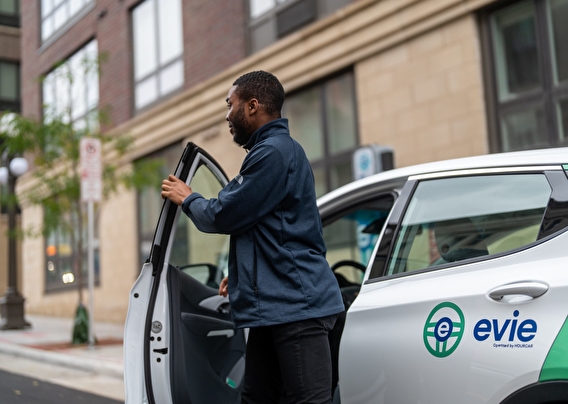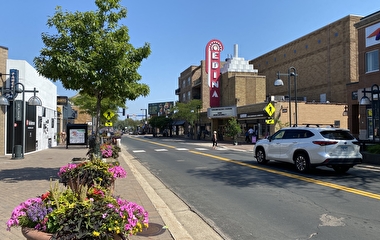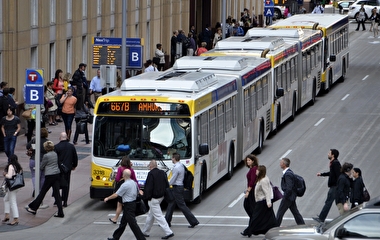
Established in 2018, the Minnesota Shared Mobility Collaborative (SMC) is working to make Minnesota a place where everyone can get around safely, affordably, and sustainably. Five years into its work, collaborative members wanted to know how they were doing—so SMC commissioned U of M researchers to study the group’s progress and determine how well their plan has been implemented so far.
The collaborative is made up of a group of transportation leaders, public agencies, private companies, city officials, and nonprofit organizations; CTS supports the program. It was formed based on recommendations from the Twin Cities Shared Mobility Action Plan, a study conducted by the Shared Use Mobility Center with funding from the McKnight Foundation. Examples of shared mobility include public transit (buses and light rail), micromobility (bikesharing and scooter sharing), and car-based options (rides on demand and carsharing).
According to SMC’s recently released progress report—supported by funding from the Minnesota Department of Transportation and Metro Transit—the collaborative has been making strides in promoting shared mobility.
“I think even people who work in shared mobility were surprised at how much progress the region has made since 2017,” says Will Schroeer, SMC chair and executive director of East Metro Strong. “One might know about this project or that project, but this report is helpful in showing how different projects are coming together to create a real shared mobility system.”
Something that struck Camila Fonseca-Sarmiento was “the number of efforts implemented to promote shared mobility across the region and the reception of the community.” Fonseca-Sarmiento is director of fiscal research at the Humphrey School of Public Affairs’ Institute for Urban and Regional Infrastructure Finance and co-author of the progress report.
One of SMC’s goals was to shift households away from single-occupant vehicles and toward transit and shared mobility. Notably, the number of registered vehicles in the seven-county metro area declined by 11.9 percent between 2017 and 2021, while the number of carsharing vehicles tripled to over 300.
The number of shared bicycles and scooters also increased to 4,800. Key projects implemented during this period included the establishment of mobility hubs and bike/scooter procurement initiatives, the launch of Evie carshare, and new microtransit and vanpool pilot programs.

Another of the group’s goals was to ensure shared mobility programs cater to a diverse ridership, so initiatives were undertaken in areas with higher populations of Black, Indigenous, and People of Color (BIPOC) users. These included the Metro Transit micro pilot project (an on-demand service to improve connections to transit in parts of north Minneapolis), Lime scooter Equity Zone pricing in select St. Paul neighborhoods, and the HOURCAR Access PLUS program (offering reduced rates for low-income households). By adapting shared mobility to serve public transportation riders, these projects were designed to enhance accessibility and equity via expanded transportation options.
“We now have the nation’s largest electric carshare service, and it is serving significant numbers of low-income and BIPOC users,” Schroeer says.
While the region has made progress in expanding shared mobility, the report points out that opportunities and challenges still exist. Opportunities include the need to secure deep investments for developing a regional bus rapid transit network and high-service transit as the backbone of shared mobility. There is also potential for shared mobility services in rural areas and smaller cities. To this end, SMC recently changed its name (from the Twin Cities Shared Mobility Collaborative) as the group expands its work to a statewide focus.
“I’m proud that we are now a statewide collaborative,” Schroeer says. “Shared mobility is sometimes regarded as something for urban areas, but—as another SMC report concluded—rural Minnesotans may need shared mobility even more.”
Challenges include stabilizing shared mobility services following disruptions experienced during the COVID-19 pandemic; ensuring data security; securing stable non-federal project funding; and adopting a regional, public-transportation-centered approach to shared mobility funding and operations.
SMC has achieved significant progress in promoting sustainable transportation, but more work lies ahead to meet the region’s evolving needs and challenges.
“People’s preferences and local priorities change, technological advances appear, etcetera, and members of the collaborative will have to adapt and respond to those evolving needs,” Fonseca-Sarmiento says. “In addition, the COVID-19 pandemic significantly impacted transportation, and the long-term implications are not yet clear. Responding to those impacts will also require work.”
Schroeer says he and the other members of the collaborative are up for the challenge.
“The timing of the progress report couldn’t be better,” he says. “The just-signed Minnesota transportation omnibus bill provides historic levels of funding for several kinds of shared mobility, and the progress report outlines areas we really need to focus on. Every member of the collaborative is excited about the opportunities here.”
Writer: Maggie Biever


